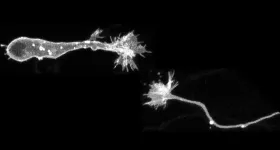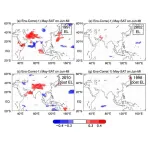(Press-News.org) Surviving childhood cancer does not always mean a clean bill of health, as the treatments that eradicate those cancers can put adult survivors at risk of new cancers and other serious health problems. Despite the existence of surveillance guidelines that recommend screening for adult cancers and other "late effects" of cancer therapy, childhood cancer survivors (CCS) are rarely up to date for recommended tests, according to a large study published in CMAJ (Canadian Medical Association Journal) https://www.cmaj.ca/lookup/doi/10.1503/cmaj.231358 led by researchers at The Hospital for Sick Children (SickKids) and Women's College Hospital.
As many as 80% of childhood cancer survivors will develop a serious or life-threatening effect, such as cardiomyopathy (heart disease) and colorectal and breast cancer, from treatment by age 45 years. The risk of colorectal cancer is 2–3 times higher than for the general population, and the risk of breast cancer in females who underwent chest radiation is similar to that of people with a BRCA mutation.
"Surveillance for late effects in adult survivors of childhood cancer is poor, placing many survivors at risk for preventable harm," writes Dr. Jennifer Shuldiner, scientist, Women's College Hospital, Toronto, Ontario, with coauthors.
In this study, researchers used Ontario provincial data on 3241 CCS who had been diagnosed with cancer between 1984 and 2014. They studied CCS who were at elevated risk of breast, colorectal cancer, or cardiomyopathy because of radiation treatments or specific chemotherapies. Of the total, 2806 (87%) were at risk for at least 1 of these late effects, 345 (11%) were at risk for 2 and 90 (3%) were at risk for 3 late effects.
The North American Children's Oncology Group has developed long-term follow up guidelines (there have been 6 versions) to monitor adults who had cancer as children.
However, the number of survivors who were following the screening recommendations was low, with 13%, 6%, and 53% adherent to colorectal cancer, breast cancer, and cardiomyopathy screening recommendations, respectively. Those who were older at diagnosis were more likely to follow the cancer screening guidelines, whereas younger age at diagnosis was associated only with higher likelihood of following screening guidance for cardiomyopathy.
A lack of awareness of the negative long-term effects of cancer treatments may underlie these low rates. Even in the case of survivors who attended specialized cancer survivor clinics, screening adherence rates were low.
"Earlier studies found that a lack of knowledge about late effects risks and surveillance recommendations among survivors, family physicians, and specialists are substantial barriers to adherence," write the authors.
Screening recommendations need to address barriers to completing screening to ensure that CCS continue to lead healthy lives as adults.
"The challenge of ensuring that CCS receive the risk-adapted health care and surveillance testing they need to maximize their long-term health and quality of life is an area of intense focus," adds Dr. Paul Nathan, director of the AfterCare Program and oncologist in the Division of Haematology/Oncology at SickKids. "Building on these findings, we will be launching a province-wide study to determine if periodic surveillance reminders for CCS and their family doctors will improve completion of these potentially life-saving tests."
The findings demonstrate a need to support patients and primary care clinicians to improve adherence to surveillance guidelines among CCS. The authors note this responsibility must be shared between the cancer care systems, particularly the provincial pediatric cancer survivor network, and the patients themselves, through advocacy and other survivor support groups.
END
Most survivors of childhood cancer don't get the tests needed to detect serious long-term adverse effects
2024-03-11
ELSE PRESS RELEASES FROM THIS DATE:
Financial toxicity affects at least one-third of patients with cancer
2024-03-11
At least one-third of Canadians diagnosed with cancer experience financial distress, called "financial toxicity," which adds to the burden of the diagnosis, write authors in a commentary published in CMAJ (Canadian Medical Association Journal) https://www.cmaj.ca/lookup/doi/10.1503/cmaj.230677.
"Financial toxicity, which refers to the direct, indirect, and emotional costs to patients following a cancer diagnosis, is increasingly recognized as a risk factor for poor health and cancer outcomes," writes Dr. Rachel Murphy, University of British Columbia and BC Cancer Research Institute, Vancouver, ...
Going top shelf with AI to better track hockey data
2024-03-11
Researchers from the University of Waterloo got a valuable assist from artificial intelligence (AI) tools to help capture and analyze data from professional hockey games faster and more accurately than ever before, with big implications for the business of sports.
The growing field of hockey analytics currently relies on the manual analysis of video footage from games. Professional hockey teams across the sport, notably in the National Hockey League (NHL), make important decisions regarding players’ careers based on that information.
“The goal of ...
For people who speak many languages, there’s something special about their native tongue
2024-03-11
CAMBRIDGE, MA -- A new study of people who speak many languages has found that there is something special about how the brain processes their native language.
In the brains of these polyglots — people who speak five or more languages — the same language regions light up when they listen to any of the languages that they speak. In general, this network responds more strongly to languages in which the speaker is more proficient, with one notable exception: the speaker’s native language. When listening ...
Blood-based marker developed to identify sleep deprivation
2024-03-09
A blood test that can accurately detect when someone has not slept for 24 hours has been developed by experts at Monash University, in Australia, and the University of Birmingham, in the UK.
This level of sleep deprivation increases the risk of serious injury or fatality in safety critical situations.
Published in Science Advances, the biomarker used a combination of markers found in the blood of healthy volunteers. Together, these markers accurately predicted when the study volunteers had been awake for more than 24 hours under controlled laboratory conditions.
The ...
Paclitaxel-coated balloon vs uncoated balloon for coronary in-stent restenosis
2024-03-09
About The Study: Among patients undergoing coronary angioplasty for in-stent restenosis, a paclitaxel-coated balloon was superior to an uncoated balloon with respect to the composite end point of target lesion failure in this multicenter randomized trial that included 600 patients. Paclitaxel-coated balloons are an effective treatment option for patients with coronary in-stent restenosis.
Authors: Robert W. Yeh, M.D., M.Sc., of Beth Israel Deaconess Medical Center in Boston, is ...
Deciphering the tip of migrating neurons: Discovery of growth cone in migrating neurons involved in promoting neuronal migration and regeneration in the brain after injury
2024-03-09
The structure and functions of the tip of migrating neurons remain elusive. Here, a research group led by Kazunobu Sawamoto, Professor at Nagoya City University and National Institute for Physiological Sciences, and by Chikako Nakajima and Masato Sawada, staff scientists in his laboratory, has found that the PTPσ-expressing growth cone senses the extracellular matrix and drives neuronal migration in the injured brain, leading to functional recovery.
Neural stem cells are present in the postnatal mammalian brain and produce new neurons. New neurons ...
Land or sea? Scientists reveal effect of land conditions on Asian monsoon climate
2024-03-09
Tokyo, Japan – Researchers from Tokyo Metropolitan University have used numerical simulations to show how conditions on land impact weather during Asian summer monsoons. Focusing on the Tibetan plateau, they studied how varied land conditions combined with fixed maritime conditions illuminate the specific effects of the land on the weather. They found that the significance of land-atmosphere coupling varies greatly from year to year, with unexpectedly low dependence on maritime phenomena like El Niño.
Asian monsoon systems impact some of the most highly populated areas of the world, affecting enormous swathes of Asia and ...
What heat can tell us about battery chemistry: using the Peltier effect to study lithium-ion cells
2024-03-08
Batteries are usually studied via electrical properties like voltage and current, but new research suggests that observing how heat flows in conjunction with electricity can give important insights into battery chemistry.
A team of researchers at the University of Illinois Urbana-Champaign has demonstrated how to study chemical properties of lithium-ion battery cells by exploiting the Peltier effect, in which electrical current causes a system to draw heat. Reported in the journal Physical Chemistry Chemical Physics, this ...
NRL participates in international campaign investigating polar low phenomena
2024-03-08
WASHINGTON – U.S. Naval Research Laboratory (NRL) research meteorologist James Doyle, Ph.D., joins an international team of scientists to investigate meteorological processes associated with Arctic cold air outbreaks.
From late February through early April, the 45-day international field campaign CAESAR, short for Cold-Air outbreak Experiment in the Sub-Arctic Region, is focused on cold-air outbreaks that occur as cold Arctic air flows-out over warmer open waters between northern Norway and ...
Are mountains carbon dioxide sources or sinks? New study finds they can be both
2024-03-08
There’s been a long-running debate in Earth sciences over whether mountains are a source of carbon dioxide or if they remove carbon dioxide from the atmosphere through mineral weathering. A new study has found that mountains can be sources or sinks and has identified the tipping point at which they switch from one to the other.
The study — by Ludwig Maximilian University of Munich, Colorado State University and the German Research Centre for Geosciences — found that many mountains exist on a spectrum of removing or releasing carbon, and erosion rates determine the impact of mountains ...




